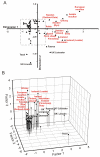Revealing the history of sheep domestication using retrovirus integrations
- PMID: 19390051
- PMCID: PMC3145132
- DOI: 10.1126/science.1170587
Revealing the history of sheep domestication using retrovirus integrations
Abstract
The domestication of livestock represented a crucial step in human history. By using endogenous retroviruses as genetic markers, we found that sheep differentiated on the basis of their "retrotype" and morphological traits dispersed across Eurasia and Africa via separate migratory episodes. Relicts of the first migrations include the Mouflon, as well as breeds previously recognized as "primitive" on the basis of their morphology, such as the Orkney, Soay, and the Nordic short-tailed sheep now confined to the periphery of northwest Europe. A later migratory episode, involving sheep with improved production traits, shaped the great majority of present-day breeds. The ability to differentiate genetically primitive sheep from more modern breeds provides valuable insights into the history of sheep domestication.
Figures




Comment in
-
Genetics. It's a bull's market.Science. 2009 Apr 24;324(5926):478-9. doi: 10.1126/science.1173880. Science. 2009. PMID: 19390037 No abstract available.
References
-
- College S, Conolly J, Shennan S. European Journal of Archaeology. 2005;8:137.
-
- Price TD. Europe’s First farmers. Cambridge University Press; Cambridge: 2000.
-
- Barker G. In: Examining the Farming/Language Dispersal Hypothesis. Bellwood P, Renfrew C, editors. McDonald Institute Monographs; Cambridge: 2002. pp. 151–162.
-
- Harris DR, Gosden C. In: The Origins and Spread in Agriculture and Pastoralism in Eurasia. Harris D, editor. UCL press; London: 1996. pp. 370–389.
Publication types
MeSH terms
Substances
Associated data
- Actions
- Actions
- Actions
- Actions
- Actions
- Actions
- Actions
Grants and funding
LinkOut - more resources
Full Text Sources
Other Literature Sources

